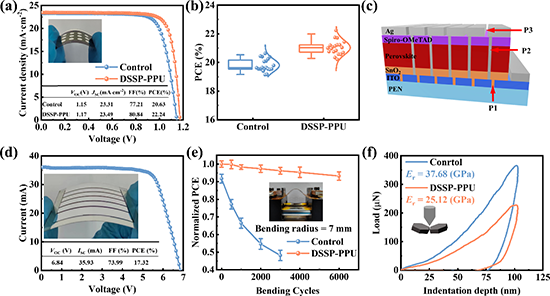具有重量轻、成本低、易于集成的柔性钙钛矿太阳电池(F-PSCs)有希望补足传统刚性硅太阳电池的应用领域,如建筑一体化光伏、可穿戴和便携式电子设备等。然而,由于钙钛矿薄膜固有的脆性和由此引起的韧性断裂所导致的机械稳定性问题严重限制了F-PSC的光伏性能和寿命。因此,解决F-PSCs的机械稳定性是其实现商业化的基础。
近日,华南师范大学高进伟/姜月团队通过将超分子PDMS聚氨酯(DSSP-PPU)组成的动态“韧带”引入钙钛矿太阳电池的晶界,促进残余应力的释放和晶界的软化。此外,这种动态“韧带”表现出优异的自愈合特性,能够在室温下愈合钙钛矿薄膜中的裂纹。所获得的钙钛矿太阳电池对于刚性衬底和柔性衬底分别实现了23.73%和22.24%的功率转换效率,对于柔性微型模块也实现了17.32%的功率转换效率。值得注意的是,在F-PSCs经受8000次弯曲循环(r = 2 mm)后,F-PSCs仍保持其初始效率的近80%,并且通过室温自愈合过程进一步恢复至初始效率的近90%。柔性和自愈合“韧带”策略为提高 F-PSC 的耐用性和性能提供了一种简单而有效的解决方案并促进F-PSC的商业应用。

Figure 1. a) Chemical structure of PDMS-PPU. b) Top-view (upper row) and cross-sectional (lower row) SEM images of perovskite films on SnO2/ITO with variable concentration of DSSP-PPU. Scale bars: 500 nm. c) XRD spectra of perovskite films with and without DSSP-PPU. d) HR-TEM of perovskite with DSSP-PPU, the right panels showing the enlarged regions of “1 and 2.” e) GIXRD with different instrumental ψ values (0°–50°) for perovskite with and without DSSP-PPU. f) Linear fit of 2θ-sin2ψ for perovskite with and without DSSP-PPU.

Figure 2. a) Chemical structure of PDMS-PPU. b) Top-view (upper row) and cross-sectional (lower row) SEM images of perovskite films on SnO2/ITO with variable concentration of DSSP-PPU. Scale bars: 500 nm. c) XRD spectra of perovskite films with and without DSSP-PPU. d) HR-TEM of perovskite with DSSP-PPU, the right panels showing the enlarged regions of “1 and 2.” e) GIXRD with different instrumental ψ values (0°–50°) for perovskite with and without DSSP-PPU. f) Linear fit of 2θ-sin2ψ for perovskite with and without DSSP-PPU.

Figure 3. a) Chemical structure of PDMS-PPU. b) Top-view (upper row) and cross-sectional (lower row) SEM images of perovskite films on SnO2/ITO with variable concentration of DSSP-PPU. Scale bars: 500 nm. c) XRD spectra of perovskite films with and without DSSP-PPU. d) HR-TEM of perovskite with DSSP-PPU, the right panels showing the enlarged regions of “1 and 2.” e) GIXRD with different instrumental ψ values (0°–50°) for perovskite with and without DSSP-PPU. f) Linear fit of 2θ-sin2ψ for perovskite with and without DSSP-PPU.

Figure 4. a) Chemical structure of PDMS-PPU. b) Top-view (upper row) and cross-sectional (lower row) SEM images of perovskite films on SnO2/ITO with variable concentration of DSSP-PPU. Scale bars: 500 nm. c) XRD spectra of perovskite films with and without DSSP-PPU. d) HR-TEM of perovskite with DSSP-PPU, the right panels showing the enlarged regions of “1 and 2.” e) GIXRD with different instrumental ψ values (0°–50°) for perovskite with and without DSSP-PPU. f) Linear fit of 2θ-sin2ψ for perovskite with and without DSSP-PPU.

Figure 5. a) Chemical structure of PDMS-PPU. b) Top-view (upper row) and cross-sectional (lower row) SEM images of perovskite films on SnO2/ITO with variable concentration of DSSP-PPU. Scale bars: 500 nm. c) XRD spectra of perovskite films with and without DSSP-PPU. d) HR-TEM of perovskite with DSSP-PPU, the right panels showing the enlarged regions of “1 and 2.” e) GIXRD with different instrumental ψ values (0°–50°) for perovskite with and without DSSP-PPU. f) Linear fit of 2θ-sin2ψ for perovskite with and without DSSP-PPU.
华南师范大学姜月副研究员和高进伟教授为论文的通讯作者,华南师范大学博士研究生杨正池为论文第一作者。感谢国家自然科学基金(No. 62105124,)广东省基础与应用基础研究基金(No. 2022B1515120006, 2022A1515010264)等对本文的资助。相关成果以" Supramolecular polyurethane "Ligaments" Enabling Room-Temperature Self-Healing Flexible Perovskite Solar Cells and Mini-modules"为题发表在期刊《Small》上。
原文链接: https://doi.org/10.1002/smll.202307186





